PETER WIHTOL has written an article on the ‘Seehund’ which appeared in the SubCommittee Report, has an article on the ‘Biber’ as well as one on ‘accessories’, coming out in that publication. Photos sent by PETER out of Kriegsmarine and OSS Photos
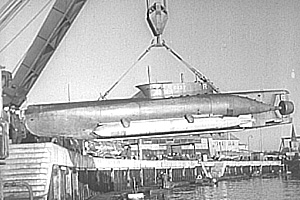 WE GOT A 1:1 SCALE, 39 FOOT SEEHUND NOW WHAT DO WE DO?
WE GOT A 1:1 SCALE, 39 FOOT SEEHUND NOW WHAT DO WE DO?
HISTORY CLARIFIED
The Seehund was the best German midget submarine design to come out of WWII. It was highly maneuverable. It had a fast, 15 second diving time and carried two, externally mounted (neutral density) G7e torpedoes. The first purpose of the Seehund was to be a defensive weapon, 1,000 of them were supposed to be built, to torpedo the Allies’ invasion fleet. The invasion happened in June 1944, but the Seehunds did not become operational until 1 JAN 45. Only 285 of them were built and just 138 were commissioned. The second purpose of the Seehunds, and other defensive small craft, was to be interim weapons, to hold off the invasion of the Allied barbarians – who were already inside the gates.
These small craft were also intended to increase the morale of the German troops and the civilians, and this was supposed to buy time until enough new super weapons were produced, to enable the Germans to win the war. But these many, hot-technology, super weapons would be too few, and would come late.
After the war the US claimed that the Seehunds sank over 100,000 tons of Allied ships. The record was 8 ships sunk and 3 damaged. There were 142 sorties with 35 Seehunds sunk in battle. Historians are now noting that the greatest effect of German midget submarines was that they tied up about 1,000 Allied ships and boats plus some precious aircraft to protect against this threat.
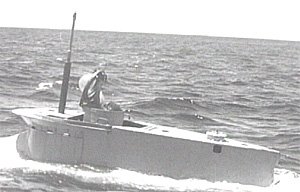 WE GOT THE SEEHUND!
WE GOT THE SEEHUND!
Whilst tracking down the real story about a phantom U-boot sunk off of the Cape Cod area (which is another long story) I met Jim Fahey, (Member #5617) historian/curator of the USS Salem Museum. One day Jim gave me a call, he was in the process of getting the Seehund, a German midget two man submarine from the USS Nautilus Museum. The Nautilus Museum needed to make space so that they could get the US Navy’s X-1, a fifty foot, four man midget submarine. The X-1 would be coming from Annapolis and the Naval Academy. And the US Government wanted our Seehund to get a good home, since she needed a lot of TLC. Jim was the hands-on, fix-em-up person of the museum and I was a good information gatherer. There was little information about the two Seehunds that came from the Nautilus Museum and the Washington Navy Yard. The reason for this simply was that both places had concentrated on the histories of US Naval ships and submarines. This lack of information about our Seehund was like waving a red cloth in front of a bull. I wanted to find out as much information as I could about her. And a 55+ year-old, cold trail, with some classified documents tossed in, was a worthy challenge.
The 075’s ride to Quincy Mass. produced a lot of puzzled stares from the drivers on I-95. When was the last time you passed a U-boat on the interstate? Then, Jim had the tractor and low-boy make a short side trip to his Braintree Elk’s Club. Jim boldly stepped into the bar and loudly announced “Did anyone here order a large sub?” (In this area a sub is a large, long sandwich.)
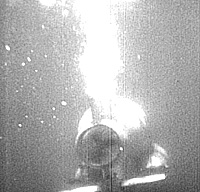 THE PAPER CHASE BEGINS
THE PAPER CHASE BEGINS
About a year-and-a-half ago I had upgraded my home computer from a double disc drive (5 ¼ inch!) dedicated word processing dinosaur to a new-fangled HP, that was Internet surfable. The first search produced a website which in turn produced my initial bibliography of about 10 books about midget submarines. I ordered them from my local public library on interlibrary loan. About a month-or-so later one of the books I received was Die Seehunde, by Klaus Mattes. It is the Holy Grail of information for Seehund followers – it is the only book solely devoted to Seehunde (Seehunde with an “e” on the end is the German plural). It had come from the Library of Congress!!!!! In the past, working for a biotech company, I have gotten many books on loan from private company libraries, college and university libraries and some very interesting “think tanks.”
A search of the references in Die Seehunde produced a grand total of about 20 books on Seehunds. There were more books and references but most of the German language ones were not obtainable here in the US. At about this same time I had discovered the website for the SubCommittee, and its Message Board, and a lot of very helpful people who are most generous and willing to share needed information. The US National Archives produced the 65-odd page, WWII German Midget Submarine file, a collection of reports and memos dating from 1942 and ending in JAN 45. But there was only one with a hint of the Seehund:
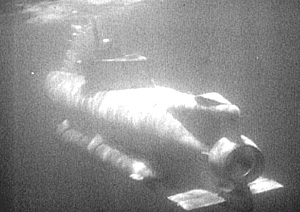 INTERPRETATION REPORT NO. A.397
INTERPRETATION REPORT NO. A.397
“These 40’ Midget U-boats differ from Midget U-boats seen hitherto, as they have the “conning tower” amidships or almost amidships instead of well aft and their dimensions appear to be:
Length 40 feet Beam about 7 feet.”
An interesting coincidence? The first day that Seehunds had become operational plus a few days before and after were all documented in this report based on the Brit’s aerial recon photos. I also learned that the Seehund operational base was IJmuiden and thanks to my being given the correct spelling of this port (the devil is in the details) I was able to pick up a lot more information on the internet about “Fortress IJmuiden.” This area still is all heavily reinforced concrete bunkers and buildings. If the Allies decided to invade here, the war would probably still be going on. There are some very interesting Dutch websites covering these structures and their history. While other countries have been destroying similar structures, the Dutch at IJmuiden have turned these bunkers and structures into a tourist attraction.
We learned that there was an OSS film “Sneak Craft” that was shown in part on the History Channel. It showed U-5075 and Commander Arnold Krug. One day, the History Channel people stopped at the Salem Museum to get some updated video imagery of “Our Hund.” They left off a copy of the original Sneak Craft video. It contained several scenes of Commander Krug and U-5075 not shown on the TV. We eventually learned that the National Archives had the 35mm uncut and unedited version of this film. Eventually we intend to get a copy of this – but now we have other details and problems to contend with.
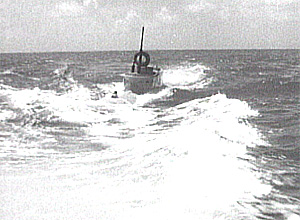 GERMAN WEBSITES AND DEALING WITH THE LANGUAGE
GERMAN WEBSITES AND DEALING WITH THE LANGUAGE
A major find of Seehund information was German U-boot websites. The best approach is to use google.com as a search engine and then use the German spelling for keywords of interest. When you find articles or sites of interest, simply click onto “[Translate this page]” this will give you a machine (computer) translation in rather brutal English. Suggested search terms to initially use are: 1. Seehund U-boot. 2. Seehund U-boot 1:35. 3. Seehundfahrer. 4. Festung IJmuiden.
DETAILS ONLY A MODELER WOULD LOVE
Color.
Thanks again to SubCommittee members we learned that a Seehund’s color and the color of her G7e torpedoes was US Haze Gray # 5-H. Soon after WWII our Seehund resided in front of the administrative building at SubBase New London. (Yes, I know it’s really in Groton, but Groton used to be a suburb of New London!) Anyway, it was painted gloss black with a 1½ foot diameter white circle and the broken cross (Swastika) on the conning tower. Then the broken cross was painted out and she was taken to the Nautilus Museum and an “HU-75” was painted on the conning tower.
Markings.
Some WWII photos of Seehunds had the three last digits of their number painted boldly on the conning towers. But many of the operational Seehunds were just a plain gray and some even were painted a spotted camouflage. (I was a medic in the reserves many years ago. And in case of war, one of the first things I would do would be to get rid of that helmet with the big, red cross painted on its sides.) German websites show Seehunds in German museums sporting three digits, a simple WWII Iron Cross and unit or flotilla insignia. Some WWII photos also showed the boat’s draft marks at the bow.
An inspection of the video of our 075 taken just after the end of the war shows NO markings on her. Jim Fahey decided to redo the paint job. About 35# of rust (that’s about a 2½ gallon bucket full) was chipped off of the conning tower. Then, some, but not too much filler was used before the repaint job. He used the original gray color and decided to go for the museum-style markings displaying “075” in rounded numbers and a WWII Iron Cross on the conning tower. We had a US Navy vet criticize us about the rounded numbers. “US Naval ships used squared numbers!” I guess it didn’t dawn on the dude that this was a U-boat and it had probably come from a foreign country.
Structural differences.
I visited the submarine museum in Hackensack, NJ. They also have a Seehund. It was the one that was formerly kept at the Washington Navy Yard. It is an early model, sporting a double rudder behind the propeller. (I incorrectly believed that this design did not work as well as the Kort Jet style, which is a turnable cylinder surrounding the propeller and which directs all of the prop wash in one direction. Trivia: other terms are also used for the “Kort Jet.”) On the front and sides of the conning tower were flanges intended for small windows for the commander. These flanges are welded close. The upper pivot point for the rotating double rudder was made of about a six foot long, carved piece of oak!!!!!!
My first guess was that there was some sort of design problem and that a quick fix was done in wood!!! If you look at the stern of our U-5075 it has an elongated diamond-like reinforcement above the upper Kort Jet pivot point. I have not noticed this is detail in other boats. My subsequent guess was that, early on, there was either a materials or a design failure at this location and these were the temporary, quick-and-dirty remedies – remember; “the Barbarians were already inside the gates.”
Differences are the rule.
My SubCommittee message board postings have gotten the attention of about a dozen-or-so individuals having a strong interest in Seehunds. Bob Dimmack of OTW Designs was one such person. He and his company were preparing to produce a Seehund kit in a 1/9th scale. He had a number of questions about our 075 and he needed many close-up photos of our Hund. He made some observations of interest to SubCommittee members. The really bad news for detail conscious modelers: There were many differences in the Seehunds produced. There was an evolution of the design and differences in the details, often from boat-to-boat. The Seehund was built in three major sections (probably at three different facilities) and the conning tower was an additional, minor, add-on section. These sections were built by displaced persons and by semi-skilled labor. Incidentally, during WWII Bob had been shooting at the reflections off of the Seehunds’ Plexiglas domed hatch covers. It’s a small world.
 OUR GOALS IN COLLECTING INFORMATION
OUR GOALS IN COLLECTING INFORMATION
A lot of good sailors died on both sides during WWII. We must tell the stories of both sides….. accurately…. without prejudice. Not to tell their stories is to commit the sin of ignoring their sacrifices and making small of their almost-impossible achievements. One example: too many US vessels were being sunk by U-boats just off of our Atlantic Coast. At Hyannis Field the Naval pilots were sitting in their airplanes for the entire time of their shift. Every 20 minutes they would go through a pre-flight checkout, then start up and warm up their engines. This, according to one veteran pilot, went on, over and over, for several weeks. This all was done so that the planes could take off immediately when a U-boat was spotted or when a ship was torpedoed. Not accurately telling history will also lull our military officers and our civilians into a false sense of security and we would be setting ourselves up for yet another military disaster.
Here are two stories of the dark side of official American history telling. The USS Eagle, a subchaser was sunk just outside of Portland Maine harbor. It was two weeks before the end of WWII and she was sunk by U-853. 49 dedicated US Navy, American sailors died. And the US Navy’s official report was simply that the boilers blew up. There was an inference that the explosion could have been due to the crew’s stupidity. History is now being rewritten and the families of these sailors will be belatedly getting 49 Purple Hearts in the spring of 2002. The second story is that the US and the US Navy obscured the death rate and the sacrifices of members of the US Merchant Marine until only a few years ago.
EDITOR NOTE – It was PAUL LAWTON (4628-1996) who doggedly dug and dug into the files to prove that USS EAGLE was a victim of U-853, not an internal explosion. It was PAUL’s hard work that brought the Purple Hearts to those who so richly deserved them.
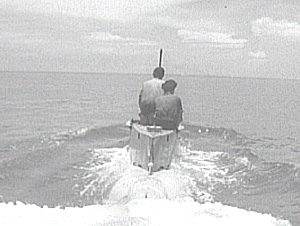 We were lucky enough to be able to send one rather long-and detailed letter to U-5075’s Commander Arnold Krug. It had a number of photos of U-5075 in her new paint job. Commander Krug was very happy to get the photos and sent us an e-mail and one rather long letter. He died of cancer on 18 December 2001. After New Years, Jim Fahey and I held a small memorial service next to his U-boot. Later that day we raised a toast (of Beck’s bier) to Arnold and his Leading Engineer, Mr. Zedelius – it’s a “male thing.” We are keeping Arnold’s family updated on what we are doing with 075 and we tentatively plan to visit them this summer and make copies of his paperwork.
We were lucky enough to be able to send one rather long-and detailed letter to U-5075’s Commander Arnold Krug. It had a number of photos of U-5075 in her new paint job. Commander Krug was very happy to get the photos and sent us an e-mail and one rather long letter. He died of cancer on 18 December 2001. After New Years, Jim Fahey and I held a small memorial service next to his U-boot. Later that day we raised a toast (of Beck’s bier) to Arnold and his Leading Engineer, Mr. Zedelius – it’s a “male thing.” We are keeping Arnold’s family updated on what we are doing with 075 and we tentatively plan to visit them this summer and make copies of his paperwork.
WHAT IT WAS LIKE TO CREW ON A SEEHUND? COLD. CRAMPED. DAMP. NO SLEEP AND…… NO TOILET!!!!!
- The commander, who was often standing, head behind the open hatch cover, quickly became drenched by spray. The top of the conning tower was about three feet above the water line.
- Seehund training began in the early fall of 1944 and then Seehunds were operational from Jan. to Apr of 45. This was in the North Sea. The water was very cold. It was windy and the waves and seas were often high and close together – the worst kind. The walls of the Seehunds were always cold. Moist air condensed on everything.
- The two-man crew got almost no sleep. (The Brits in their four-man crew “X” Craft midget sub had a big enough crew so that they could get some sleep.)
- In articles written by Seehund veterans they almost always remind the reader that there was no toilet. Instead, the crew would be on a special “clinker-free” [literal translation] diet for days before a mission. When was the last time you saw your favorite TV hero go to the bathroom? What actually happened “potty-wise” is one of the bigger secrets of WWII and I will not be the one to reveal details of this most closely-kept secret.
- During initial Seehund training, there was a high mortality rate due to: some initial design flaws; the need for more training; brand-new boats with problems turning up during breaking-in period. And finally, routine (expectable) mechanical problems.
- When they started performing combat missions there was initially a high mortality rate due to submariners needing still more training. Later, the training apparently improved. [Actually the training was quite good except that it was in much calmer waters.]
- This was a midget submarine with reduced safety margins, limited accessibility of components and a new design of submarine being tested-and-evolved. Instead of redundancy of parts, there was multiple use and purpose. For example, the electric motor driving the propeller also served as the generator plus it served as the starting motor as well. If anything failed, you were in extraordinarily big trouble.
- Incidentally, many deaths initially occurred due to carbon monoxide poisoning. [This statement is incorrect. It was the Biber, with a gasoline engine that produced CO deaths.]
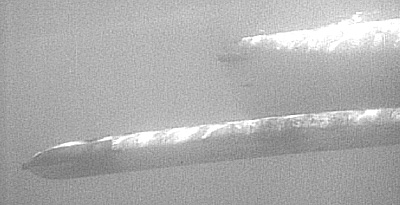 TWO TYPES OF WEAPONS
TWO TYPES OF WEAPONSTwo, type G7e torpedoes.
The torpedoes were gyroscopically controlled and they were “line of sight” fired and guided. Wherever they were aimed at when they were fired was where they went. This sounds O.K. until you are in a Seehund, looking through a periscope, bouncing up and down and encountering very large waves and seas. You’d have a problem keeping your Hund pointed at, or ahead of the target. You had to continually correct the course and your boat would be oscillating up and down, left and right. A neat, straight torpedo shot was not possible. You had a rather large cone of fire. If it wasn’t for the torpedoes having a fixed depth and a few trivial laws of physics, flying seabirds would also be at risk.
One 9mm pistol was to be used to facilitate escape and evasion over land, and it was to be used to shoot out the lights of navigational aids in enemy waters. Proper boating etiquette was being deferred until after the war.
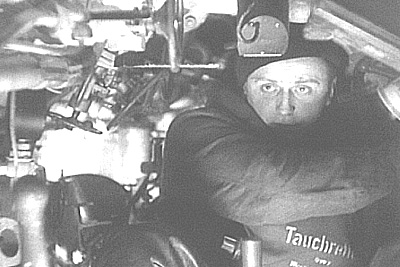 WHAT IT IS LIKE TO BOARD OUR U-5075?
WHAT IT IS LIKE TO BOARD OUR U-5075?First I would be barking at you frequently not to step onto the thin parts of the conning tower. Then you would discover that the hatch opening is rather small in diameter and that your body is rather large in diameter. You would be looking for a ladder to climb down, into the hull. There is none. Then, you will be looking for footholds. There are a few, but choose wisely and choose well. Remember where they are!! When your waist and shoulders are passing through the hatch, you will not be able to look down to see your feet and those precious few footholds. Next problem is passing your broad shoulders through the small diameter hatch.
Holding your arms straight above your head will help. There is one, low, rubberized step to stand on and once you reach the inside deck you discover there is not much room. It looks like a terrible mess inside. All of the major parts and components are still there but cosmetically it looks like someone popped off a grenade inside. The smaller items and things that weren’t securely bolted down like the periscope optics, radio, control handles and labels are all missing. Ditto both seats for the crew. One can see daylight coming in through holes rusted through the lower part of the pressure hull. We are generally too embarrassed to invite guests inside to visit.
Getting out is about as bad as getting in except that first, you have to figure out how to get your shoulders through that tiny hatch and still be able to use your arms to haul yourself up and out. Then as a final insult to your body, your feet will tend to get stuck near the top of the hatch and you have to use your hands to twist and turn them, twist them some more, and then pull them out. All of this is happening while you are trying not to fall off of the small conning tower.
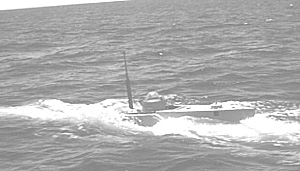 Once you get back home and do some quiet rethinking, you might visualize TWO, poor crew members trying to quickly exit a sinking Seehund or trying to do an underwater exit wearing “lifesaving” gear. That safety gear would likely snag on one of the many controls and parts. The final kiss of death? The water temperature was about 40 degrees F.
Once you get back home and do some quiet rethinking, you might visualize TWO, poor crew members trying to quickly exit a sinking Seehund or trying to do an underwater exit wearing “lifesaving” gear. That safety gear would likely snag on one of the many controls and parts. The final kiss of death? The water temperature was about 40 degrees F.
The first operational mission for Seehunds was 1 January 1945.
- Eighteen Seehunds left IJmuiden.
Only two returned.Thanks PETE – great piece!
Sneak Craft: German Biber Mini-Submarines
Sneak Craft: U-5075 Hund Mini-Sub
Sneak Craft: U-Boat Accessories 1944
Back to KTB # 172 Table of Contents
Back to KTB List of Issues
Back to MagWeb Master Magazine List
© Copyright 2003 by Harry Cooper, Sharkhunters International, Inc.
This article appears in MagWeb.com (Magazine Web) on the Internet World Wide Web. Other articles from military history and related magazines are available at http://www.magweb.com
Join Sharkhunters International, Inc.: PO Box 1539, Hernando, FL 34442, ph: 352-637-2917, fax: 352-637-6289, www.sharkhunters.com
